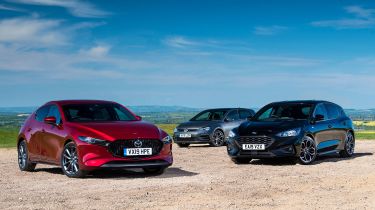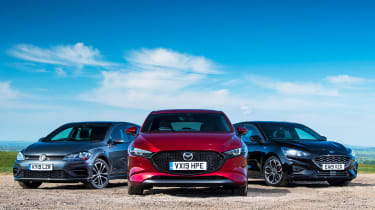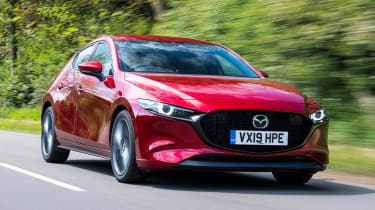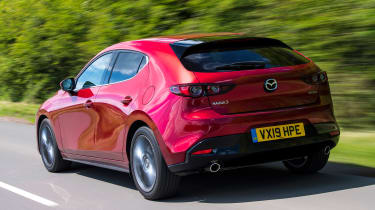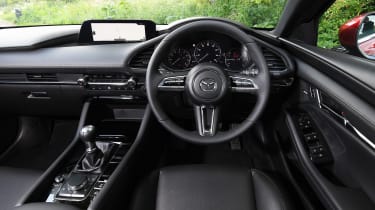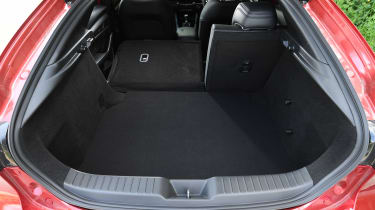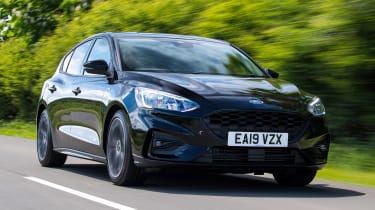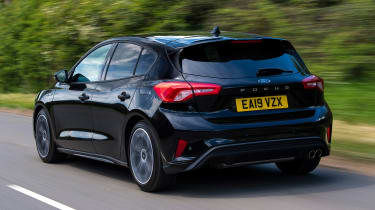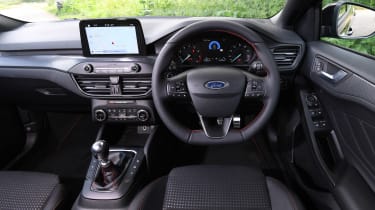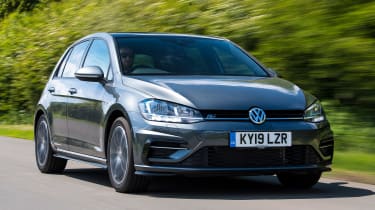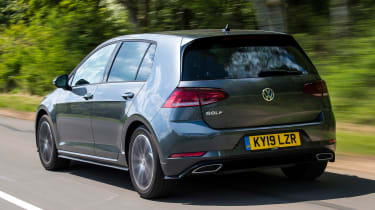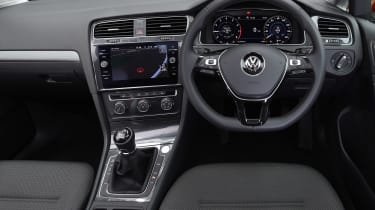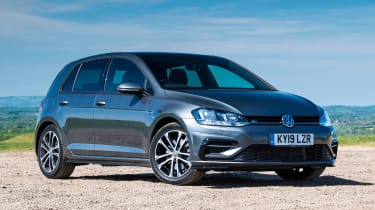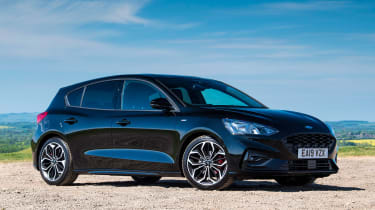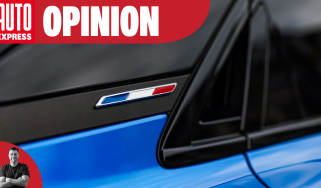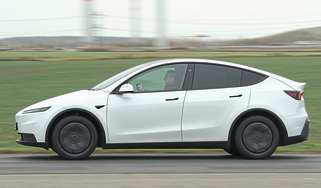Mazda 3 vs Ford Focus vs Volkswagen Golf
The new Mazda 3 aims to muscle in on the UK’s best-selling family hatchbacks, the VW Golf and Ford Focus. We put it to the test
The fight for first place in the family hatchback class is massively important in the UK. According to the Society of Motor Manufacturers and Traders, the Volkswagen Golf and Ford Focus are the second and third best-selling cars so far this year in Britain; these models are right at the top of this large market segment.
However, the new Mazda 3 has its sights set on challenging the Golf and Focus, and the newcomer has the potential to overhaul both of these popular family five-doors.
The Japanese brand continues to tread its own path, with a line-up of naturally aspirated petrol engines, but it has revamped the exterior and interior design of the new 3 to better compete with rival models.
There’s more kit than before, too, but in this class, getting one or two things right isn’t enough. The Golf and Focus are some of the best all-rounders on sale, with a mixture of everything you might be looking for in a car, from practicality to performance and equipment to economy. The Mazda has a mountain to climb if it wants to sit on the same peak as these two titans. Here we’ll find out if the 3 has what it takes to make the ascent to the top of the class.
Mazda 3
| Model: | Mazda 3 2.0 SkyActiv-G M Hybrid GT Sport |
| Price: | £24,595 |
| Engine: | 2.0-litre 4cyl petrol, 120bhp |
| 0-60mph: | 9.1 seconds |
| Test economy: | 41.4mpg/9.1mpl |
| CO2: | 119g/km |
| Annual road tax: | £135 |
There are only two engines available in the Mazda 3 for now: a 114bhp diesel unit and this 120bhp petrol. In manual form and GT Sport trim as tested here, it costs from £24,595, placing it in between the Ford and the Volkswagen on price.
Design & engineering
The new Mazda 3’s bold exterior design signals a complete overhaul for the Japanese family hatch in 2019, although the brand has focused on fixing niggles with the old model rather than going for a revolutionary change. That transformation could come in the form of the firm’s SkyActiv-X engines later on, but for now it has a mild-hybrid 2.0-litre petrol under the bonnet and a six-speed manual gearbox driving the front wheels.
Used - available now
There are MacPherson struts up front, as is standard for the class, and a torsion beam at the back. That’s a cheaper rear arrangement than in the old car, but it hasn’t upset the 3’s handling, as we’ll see.
Engineering is a strong point for Mazda and the manufacturer has a few tricks up its sleeve in the 3, including mild-hybrid assistance for the engine, clever torque-controlling tech called G-Vectoring and weight-saving materials to help improve the newcomer’s performance and fuel economy.
Mazda has worked on the interior of the 3, too, and it’s now among the best cars in its class for cabin design and finish. Not only is it good to look at, the passenger compartment is also made from high-quality materials; they’re consistently better than in the Focus and mostly better than the Golf in this spec, while build quality is great as well. Combined with much-improved new infotainment, it’s a big step up.
The amount of kit is superb as well. GT Sport cars have 18-inch alloys, heated leather seats, sat-nav, smartphone connectivity, blind spot and lane-keep assistance, LED lights and a reversing camera.
Driving
The Mazda’s excellent driving position gets it off to a good start here, and as soon as you put it in first gear it’s clear that the gearbox is one of the best in its class. It’s tactile and has a mechanical feel without being notchy or unpleasant – just like in all other Mazdas. The steering doesn’t have much feel, but the wheel rim is thin and great to hold, and the speed and weight of the rack are good, too – in contrast to the slightly-too-quick set-up in the Ford.
Turn into a corner and there’s plenty of grip and just enough body roll to provide some information about what the chassis is doing – and thanks to clever G-Vectoring tech that reduces engine torque when you turn in to put more weight on the nose, the 3 feels responsive and keen to corner. It’s no sports car, but with its precise controls and a little adjustability in bends, the Mazda is just as much fun from behind the wheel as the Focus.
It’s comfortable as well. While the 3 isn’t as settled as the Volkswagen at speed, the Mazda deals with rough roads and potholes very well, and it’s slightly smoother than the Focus overall.
The Mazda’s 2.0-litre engine is revvy, yet still delivers its power in a smooth, linear manner, but most buyers might prefer the low-down torque available in its turbocharged rivals. The mild-hybrid system provides a tiny boost on initial acceleration, and it means the stop/start system works very smoothly, but it’s otherwise imperceptible.
When it came to the 0-60mph sprint, the Mazda was quicker than both of its rivals, taking just 9.1 seconds (the Ford needed 9.9 seconds and the VW completed the task in 9.6 seconds), but its lack of a turbocharger was obvious in our in-gear tests.
The 3 took 7.1 seconds to go from 30-50mph in fourth gear, which was 0.4 seconds behind the Focus and a full second behind the Golf. Plus it needed 13.8 seconds to go from 50-70mph in top gear, 1.1 seconds behind the Focus and 1.7 seconds adrift of the Golf.
Practicality
The Mazda 3 loses out for practicality. Its 351-litre boot is smaller than both of its rivals’ capacities, and they are only average in the family hatch class. The stylish roofline and rear hatch mean access to the load bay isn’t as good as in its competitors, either, and the small rear windows make it dark in the back seats.
Still, it’s actually surprisingly spacious in the rear, with more legroom than the Focus (but not the Golf) and about the same headroom. Tall adults will brush against the roof, but the seating is low enough that they won’t be too uncomfortable. The front seats are much better; they provide plenty of support and their position is superb. There’s a lot of space in the cubby ahead of the gearlever and in the centre console, too.
Ownership
The Mazda is the best-equipped model here when it comes to safety kit, because it includes AEB, a reversing camera, lane- keep assist, adaptive cruise and blind spot assist.
In contrast, you’ll have to pay £1,135 for blind-spot assistance in the Golf, and £400 in the Focus, and a reversing camera is extra on both rivals as well.
Plus Mazda scored very well in our Driver Power 2019 survey. The brand took a commendable fourth place, while Ford was 23rd and Volkswagen was 17th. However, Mazda’s dealers fell behind its rivals’, coming 24th out of 28 in the rankings.
Running costs
The 3’s mild-hybrid engine returned 41.4mpg, ahead of the Golf’s 35.4mpg and the Focus’ 37.5mpg figures. The Mazda will cost £1,695 a year in fuel (12,000 miles), while the VW and Ford are £1,982 and £1,871 respectively. With decent residuals and affordable company car tax costs, the 3 is competitive for running costs.
Testers’ notes: “The 3 is ergonomically excellent. Its steering wheel, pedals, gearlever and armrests are all perfectly placed. This adds to comfort levels as well as driving satisfaction.”
Ford Focus
| Model: | Ford Focus 1.0 EcoBoost 125 ST-Line X |
| Price: | £24,405 |
| Engine: | 1.0-litre 3cyl petrol, 123bhp |
| 0-60mph: | 9.9 seconds |
| Test economy: | 37.5mpg/8.3mpl |
| CO2: | 114g/km |
| Annual road tax: | £145 |
The Ford Focus has been one of the most popular cars in Britain since it was launched in 1998, and with good reason. Here we’re testing the sporty-looking ST-Line X model with the 1.0-litre EcoBoost 125 petrol engine, which costs £24,405.
Design & engineering
This new Mk4 Focus hatch is based on Ford’s C2 platform, which uses MacPherson struts for the front suspension, while the back has a torsion beam. Some versions of the Focus get a more complex multi-link rear set-up, but this 1.0-litre model’s beam works well enough.
Like both its rivals, the Ford has a six-speed manual gearbox, and although the 123bhp engine is the smallest here in terms of capacity, it’s a little more powerful than the Mazda’s 2.0-litre petrol thanks to the use of a turbocharger. That turboalso improves torque low in the rev range, and at 1,400rpm the Focus’ engine produces the same 200Nm of torque as the 1.5-litre engine in the Golf.
The Focus’s interior is much-improved over the previous-generation model, but it falls behind the Mazda when it comes to quality. Fit and finish are good, but there are many more cheap-looking and harsher plastics around the cabin in the Ford. It has a similar design to the smaller Fiesta; while that look works in a cheaper model, it does feel a little out of place and of lower quality next to the Mazda and VW.
There’s an infotainment screen placed on top of the dashboard, which includes DAB radio, Bluetooth connectivity, sat-nav, Android Auto and Apple CarPlay as standard on our test car. ST-Line X trim also features 18-inch alloy wheels, keyless go, heated seats, climate control and parking sensors.
Driving
The Focus’ 1.0-litre engine is very impressive given its tiny capacity, but it’s underwhelming in some situations. It was the slowest from 0-60mph and from 30-70mph in our straight-line speed tests, taking 9.9 and 10.2 seconds respectively. The latter was a second behind the Mazda and 1.4 seconds behind the Golf; both rivals are quicker and their engines more willing when you’ve got your foot down.
However, the Ford unit’s strength is its in-gear pull, because while it was slower than the Golf in our tests, it did manage to pull ahead of the non-turbo Mazda 3 in each ratio. The three-cylinder isn’t quite as characterful as the best engines of its type, but still sounds fun, with a note that reminds us of the Fiesta ST’s 1.5-litre triple.
The six-speed manual gearbox isn’t as slick as the 3’s unit, but the precise action is still sweet, and all three of these cars have great transmissions.
But the Focus’s quick, well-weighted steering has more life than its rivals’ numb set-ups, and there’s lots of grip to lean on. It’s more lively than the others, too, and the chassis doesn’t compromise comfort, either; it soaks up potholes well and even big bumps in the road won’t dent your confidence.
However, it’s harder to drive smoothly than the Mazda or Volkswagen. The quick steering means you have to make smaller, more subtle movements if you want to avoid body roll, the brakes are a little grabby at the top of the pedal travel and the engine tends to hold on to revs as you change gear. While these issues aren’t huge, they mean the Mazda 3 is more satisfying to drive, even if it isn’t as lively as the Focus. The Ford isn’t quite as quiet or settled on the motorway as the Golf, either.
Practicality
If you fold the rear seats down, there’s a total of 1,354 litres of space in the Focus, which makes it the most spacious car of the three. The Golf isn’t far behind with 1,270 litres, but the Mazda’s compromised 1,019 litres means it’s the smallest. At 375 litres, the Focus’ boot is only five litres smaller than the Golf���s with the seats in place, too.
There’s enough room in the back seats for adults, although they might find legroom is a little tight with a taller driver. There’s more headroom in the Ford than in the Mazda, though, although both cars fall behind the loftier Golf in this area.
Up front there’s a versatile cup-holder and storage area in the centre console, plus space for a phone ahead of the gearlever that’s bigger than the small cubby in the Golf. However, it’s not as large as the oddments stowage section in the Mazda.
Ownership
In our Driver Power 2019 survey, Ford finished in 23rd place in the maker’s chart, a disappointing fall from a mid-table result the previous year. This puts it below VW in 17th, and well behind Mazda in fourth.
Autonomous braking with pedestrian and cyclist detection is standard, along with lane-keep assist and post-collision braking. Euro NCAP awarded the new Ford its top five-star rating when it was tested in 2018, although to match the Mazda here you’ll need to spend £400 for blind-spot assist and £500 for the Convenience Pack to add a reversing camera.
Running costs
With low CO2 emissions of 114g/km, the 1.0-litre Focus is the cheapest car here for company car buyers. It sits in the 26 per cent Benefit-in-Kind (BiK) tax bracket, so the Ford hatchback will cost lower-rate earners £1,257 per year in contributions.
The Mazda and Volkswagen both sit in the 27 per cent category, so they’re not too far behind; the 3 costs £1,316 and the Golf costs £1,329 per annum in BiK tax. These three cars are evenly matched on insurance, too, because our example quotes show a premium of £421 for the Mazda, £404 for the Ford and £406 for the VW.
Testers’ notes: “Despite the downsized engine’s small capacity compared with its rivals’ here, the tiny turbo spins up quickly, so there’s still plenty of flexibility. It doesn’t like to be revved like the Mazda, though.”
Volkswagen Golf
| Model: | VW Golf 1.5 TSI EVO 130 GT 5dr |
| Price: | £24,830 |
| Engine: | 1.5-litre 4cyl petrol, 128bhp |
| 0-60mph: | 9.6 seconds |
| Test economy: | 35.4mpg/7.8mpl |
| CO2: | 116g/km |
| Annual road tax: | £145 |
As our current class champion, the Volkswagen Golf is the car to beat. In GT trim (our pictures show an R-Line), with the 1.5 TSI manual powertrain, it costs £24,830. It’s the most expensive model here, but it’s close; the VW is within £425 of its test rivals.
Design & engineering
The Golf is based on the Volkswagen Group’s incredibly versatile MQB platform, which underpins many different cars including hatchbacks, SUVs and even coupés and roadsters in the form of the Audi TT. While the Golf features strut suspension at the front like its rivals here, it has a more sophisticated multi-link set-up at the rear in 1.5 TSI form. Dynamic Chassis Controlis an £875 option, and it adds adaptive dampers.
Volkswagen’s 1.5-litre turbocharged petrol engine produces 128bhp and a maximum 200Nm of torque, so it’s the most powerful model in this test. While the Mazda is only available with two engines at the moment, the Golf has so many variants that there’s bound to be one to fit your needs, ranging from the 1.0-litre entry-level model right up to the fire-breathing 296bhp Golf R hot hatchback.
The VW’s interior is well built and uses soft-touch materials in the right places, so it’s more upmarket inside than the Focus. However, the Mazda mixes design, build quality and materials slightly better.
An excellent infotainment system is also fitted to the VW. The eight-inch Discover Navigation set-up is standard on GT trim and includes Apple CarPlay and Android Auto smartphone connectivity, while you can also add a 12.3-inch TFT Active Info Display for £525 that replaces traditional dials behind the steering wheel – so the Golf is hi-tech, too.
GT editions also get 17-inch alloy wheels and a few exterior trim differences to give them a sportier look, plus upgraded upholstery, ambient lighting, selectable driving modes and adaptive cruise control.
Driving
The Golf is very good in nearly every aspect of the driving experience, which makes it a superb all-rounder.
Its steering is direct and accurate, if a bit too numb, and there’s plenty of grip and good body control as well. The VW doesn’t have the agility of its rivals here, but it runs them close and there’s still plenty of fun to be had from behind the wheel.
Mid-corner bumps don’t upset the Golf’s balance or composure, and while its ride isn’t perfect, it’s slightly more comfortable than its competitors. Potholes are a little more noticeable here than in the Mazda, but the German hatchback is great at smoothing out little bumps in the road, so it’s more comfortable more of the time.
Volkswagen’s 1.5-litre turbo petrol engine is a highlight, because it’s quiet and smooth, yet also punchy from low in the rev range. It took 8.8 seconds to go from 30-70mph through the gears – the fastest of the three cars – and the slick six-speed manual helps with that because it’s really easy to use, if not quite as satisfying as the Mazda’s transmission.
The Golf was also quickest from 50-70mph in fifth and sixth gears, taking 9.3 and 12.1 seconds respectively, while the Mazda needed 9.5 and 13.8 seconds and the Ford clocked 10.0 and 12.7 seconds in those tests. This means you can rely on the engine’s torque when you’re on the motorway and don’t have to change down to speed up. Slightly shorter gearing helps with this, too, although it does seem to dent economy slightly as a result.
Practicality
It’s very roomy inside the Golf and there’s lots of head and legroom in the rear seats, so it is likely to be a more popular choice with members of the family who aren’t going to be driving.
The doors open wide, while its large door bins, a big glovebox and a deep cubby between the front seats mean in-car storage is good, too. The cubbies up front aren’t as big as the Mazda’s, but there’s a place for your phone and some cup-holders.
The VW’s 380-litre boot is the biggest here as well, and the large opening means loading items will also be easier. Plus the large windows mean there’s lots of light inside, especially when compared with the Mazda 3, which is very gloomy in the back seats.
Ownership
A five-star Euro NCAP rating in 2012 is good news for potential buyers, and the Golf is even safer now due to a mid-life facelift that added AEB with pedestrian detection.
You also get adaptive cruise control and parking sensors fitted on GT models, but a reversing camera is an additional £345, while lane-keep assist and blind-spot warning are part of expensive option packs that cost £565 and £1,135 respectively – yet they’re both standard equipment on the Mazda 3.Volkswagen dropped from a strong score in 2018 to 17th in our Driver Power 2019 poll, which was disappointing, and the brand is now slightly worse than average, according to owners. Mazda finished much higher up in fourth, but Ford was ranked 23rd.
Running costs
The Golf’s 35.4mpg return on test was lower than its rivals’ fuel economy, but all three models were within 6mpg of each other during our evaluation. The VW’s predicted residual value of 41 per cent after three years was slightly lower than its competitors’. The 3 retains 46.1 per cent and the Focus keeps 43.2 per cent.
Those figures mean that the Golf will be worth £10,083 after a typical three-year ownership, resulting in a loss of £14,522. The Mazda will lose £13,269 and be worth £11,326 in that time, while the Ford will shed £13,855 and be worth £10,550.
Testers’ notes: “All these models are available with automatic transmissions, but it’s probably wise to save the cash – well over £1,000 in each model – because all three manuals are excellent.”
Verdict
First place: Volkswagen Golf
The Volkswagen Golf isn’t just the best model in this class, it’s also one of the best cars you can buy. That’s because the VW is a brilliant all-rounder; it’s great to drive, comfortable, spacious, good value, efficient and full of tech. The engine is quiet and performs well, and the infotainment system is full-featured and modern. While its rivals are a bit more fun, neither offers as wide a range of abilities as the Golf.
Second place: Mazda 3
Mazda’s latest 3 is competitive. It has a much-improved interior and is as good to drive as the Focus. Those are both true achievements, so it’s a shame it’s slightly let down by the engine, which doesn’t have the flexibility of its rivals’ motors. Still, enthusiasts will prefer its revvier nature. The Mazda is also less practical than its test competitors, but it makes up for that with a very impressive standard kit list.
Third place: Ford Focus
The difference between first and third place here is small. The Focus might be in last position, but it’s still one of the best all-round cars you can buy; it’s just that this is a highly competitive class. The Ford’s joyful handling, good practicality, efficiency and affordability are strong points, but the hatchback falls just behind the Mazda here for standard equipment, interior quality and rear-seat space.
Other options for similar money...
New: Skoda Octavia
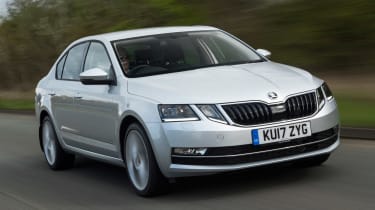
Model: Skoda Octavia 1.5 TSI 150PS SE LPrice: £22,975Engine: 1.5-litre 4cyl, 148bhp
Value for money and practicality are key selling points in this class, and it doesn’t get much better than the Skoda Octavia. You can buy a more powerful 148bhp version of the Golf’s 1.5-litre engine for less money here, and the Czech car is much more spacious.
Used: Mercedes A-Class
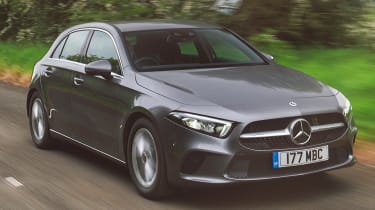
Model: Mercedes A200 AMG LinePrice: £25,450Engine: 1.3-litre 4cyl, 161bhp
If you’re looking for a premium family hatch, consider a used model. We found a 1.3-litre petrol auto Mercedes A-Class for just over £25,000 – and with 3,808 miles on the clock, it’s almost new. The Audi A3 and BMW 1 Series models are in range as well.
Figures
| VW Golf 1.5 TSI EVO 130 GT 5dr | Mazda 3 2.0 SkyActiv-G M Hybrid GT Sport | Ford Focus 1.0 EcoBoost 125 ST-Line X | |
| On the road price/total as tested | £24,830/£24,830 | £24,595/£25,385 | £24,405/£25,955 |
| Residual value (after 3yrs/36,000) | £10,083/41.0% | £11,326/46.1% | £10,550/43.2% |
| Depreciation | £14,522 | £13,269 | £13,855 |
| Annual tax liability std/higher rate | £1,329/£2,657 | £1,316/£2,632 | £1,257/£2,515 |
| Annual fuel cost (12k/20k miles) | £1,982/£3,303 | £1,695/£2,824 | £1,871/£3,119 |
| Insurance group/quote/road tax cost | 16/£406/£145 | 17/£421/£135 | 13/£404/£145 |
| Servicing costs | £297 (2 years) | £649 (3 years) | £390 (2 years) |
| Length/wheelbase | 4,258/2,620mm | 4,460/2,725mm | 4,387/2,700mm |
| Height/width | 1,492/1,799mm | 1,435/1,795mm | 1,458/1,825mm |
| Engine | 4cyl in-line/1,498cc | 4cyl in-line/1,998cc | 3cyl in-line/999cc |
| Peak power/revs | 128/5,000 bhp/rpm | 120/6,000 bhp/rpm | 123/6,000 bhp/rpm |
| Peak torque/revs | 200/1,400 Nm/rpm | 213/4,000 Nm/rpm | 200/1,400 Nm/rpm |
| Transmission | 6-speed man/fwd | 6-speed man/fwd | 6-speed man/fwd |
| Fuel tank capacity/spare wheel | 50 litres/space saver | 51 litres/repair kit | 52 litres/repair kit |
| Boot capacity (seats up/down) | 380/1,270 litres | 351/1,019 litres | 375/1,354 litres |
| Kerbweight/payload/towing weight | 1,280/500/1,400kg | 1,364/511/1,300kg | 1,322/533/1,100kg |
| Turning circle | 10.9 metres | 11.4 metres | 11.0 metres |
| Basic warranty/recovery | 3yrs (60,000 miles)/1yr | 3yrs (60,000 miles)/3yrs | 3yrs (60,000)/3yrs |
| Driver Power manufacturer/dealer pos. | 17th/18th* | 4th/24th* | 23rd/20th* |
| NCAP: Adult/child/ped./assist/stars | 94/89/65/71/5 (2012) | 98/87/81/73/5 | 85/87/72/75/5 |
| 0-60/30-70mph | 9.6/8.8 secs | 9.1/9.2 secs | 9.9/10.2 secs |
| 30-50mph in 3rd/4th | 4.4/6.1 secs | 5.3/7.1 secs | 4.8/6.7 secs |
| 50-70mph in 5th/6th | 9.3/12.1 secs | 9.5/13.8 secs | 10.0/12.7 secs |
| Top speed/rpm at 70mph | 130mph/2,250rpm | 122mph/2,400rpm | 124mph/2,500rpm |
| Braking 70-0/60-0/30-0mph | 53.7/37.0/11.8m | 53.9/35.5/10.6m | 46.1/34.1/8.5m |
| Noise outside/idle/30/70mph | 61/51/62/71dB | 69/42/63/72dB | 72/44/62/72dB |
| Auto Express econ. (mpg/mpl)/range | 35.4/7.8/389 miles | 41.4/9.1/464 miles | 37.5/8.3/429 miles |
| WLTP combined mpg | 44.1-45.6mpg | 44.8-45.6mpg | 46.3-49.6mpg |
| WLTP combined mpl | 9.7-10.0mpl | 9.9-10.0mpl | 10.2-10.9mpl |
| Actual/claimed CO2/tax bracket | 184/116g/km/27% | 158/119g/km/27% | 174/114g/km/26% |
| Airbags/Isofix/park sensors/camera | Seven/yes/yes/£345 | Seven/yes/yes/yes | Six/yes/yes/£500^^ |
| Auto box/lane-keep/blind spot/AEB | £1,415/£565**/£1,135**/y | £1,300/yes/yes/yes | £1,450/yes/£400/y |
| Clim/cruise ctrl/leather/heated seats | £450/adapt/£1,935/£410^ | Yes/adaptive/yes/yes | Yes/yes/partial/yes |
| Met paint/LEDs/keyless/pwr tailgate | £595/£1,025/£390/no | £790/yes/yes/no | £550/£750/£250/no |
| Nav/digital dash/DAB/connected apps | Yes/£525/yes/yes | Yes/yes/yes/yes | Yes/no/yes/yes |
| Wireless charge/CarPlay/Android Auto | No/yes/yes | No/yes/yes | £100/yes/yes |
